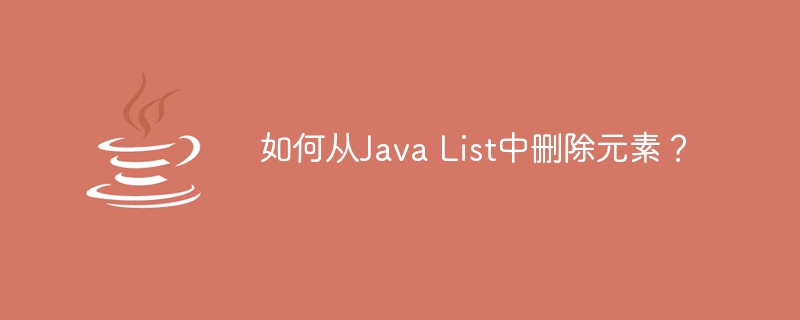How to remove elements from Java List?

The List interface is a Collection that stores a sequence of elements. ArrayList is the most popular implementation of the List interface. Lists give the user very precise control over where elements are to be inserted in the list. These elements are accessible through their index and are searchable. ArrayList is the most common implementation of the List interface.
You can remove elements from a List in a variety of ways.
Way #1
Use its index to delete elements.
Syntax
E remove(int index)
Comments
Removes an element from the specified position in the list.
Move any subsequent elements to the left (subtract 1 from their index).
Returns the element removed from the list.
Parameters
index - The index of the element to remove.
Return value
The element previously located at the specified position.
Throws
UnsupportedOperationException - if this list does not support the removal operation.
IndexOutOfBoundsException - if the index is out of range (index < 0 || index >= size()).
Method 2
Use this to remove an element.
Syntax
boolean remove(Object o)
Comments
Removes the first occurrence of the specified element from the list, if it exists.
If the list does not contain the element, it remains unchanged.
Delete the element with the lowest index i such that (o==null ? get(i)==null : o.equals(get(i))).
Returns true if the list contains the specified element (or equivalently, if the call causes the list to change).
Parameters
o - The element to be removed from the list, if present.
Return value
Returns true if the list contains the specified element.
Throws
UnsupportedOperationException - if the list does not support the delete operation.
ClassCastException - if the type of the specified element is incompatible with the list.
NullPointerException - If the specified element is null and the list does not allow null elements.
Example 1
The following is an example of removing elements by index using the remove() method. −
package com.tutorialspoint;
import java.util.ArrayList;
import java.util.Arrays;
import java.util.List;
public class CollectionsDemo {
public static void main(String[] args) {
List<Integer> list = new ArrayList<>(Arrays.asList(0,1,2,3,4,5,6,7,8,9));
System.out.println("List: " + list);
list.remove(1);
System.out.println("After remove(1), List: " + list);
}
}Output
This will produce the following result-
List: [0, 1, 2, 3, 4, 5, 6, 7, 8, 9] After remove(1), List: [0, 2, 3, 4, 5, 6, 7, 8, 9]
Example 2
The following example shows how to remove elements by object using the remove() method -
package com.tutorialspoint;
import java.util.ArrayList;
import java.util.Arrays;
import java.util.List;
public class CollectionsDemo {
public static void main(String[] args) {
List<Integer> list = new ArrayList<>(Arrays.asList(0,1,2,3,4,5,6,7,8,9));
System.out.println("List: " + list);
list.remove(Integer.valueOf(5));
System.out.println("After remove(Integer.valueOf(5)), List: " + list);
}
}Output
This will produce the following results-
List: [0, 1, 2, 3, 4, 5, 6, 7, 8, 9] After remove(Integer.valueOf(5)), List: [0, 1, 2, 3, 4, 6, 7, 8, 9]
The above is the detailed content of How to remove elements from Java List?. For more information, please follow other related articles on the PHP Chinese website!

Hot AI Tools

Undresser.AI Undress
AI-powered app for creating realistic nude photos

AI Clothes Remover
Online AI tool for removing clothes from photos.

Undress AI Tool
Undress images for free

Clothoff.io
AI clothes remover

AI Hentai Generator
Generate AI Hentai for free.

Hot Article

Hot Tools

Notepad++7.3.1
Easy-to-use and free code editor

SublimeText3 Chinese version
Chinese version, very easy to use

Zend Studio 13.0.1
Powerful PHP integrated development environment

Dreamweaver CS6
Visual web development tools

SublimeText3 Mac version
God-level code editing software (SublimeText3)

Hot Topics
 1378
1378
 52
52
 How does Java's classloading mechanism work, including different classloaders and their delegation models?
Mar 17, 2025 pm 05:35 PM
How does Java's classloading mechanism work, including different classloaders and their delegation models?
Mar 17, 2025 pm 05:35 PM
Java's classloading involves loading, linking, and initializing classes using a hierarchical system with Bootstrap, Extension, and Application classloaders. The parent delegation model ensures core classes are loaded first, affecting custom class loa
 How do I implement multi-level caching in Java applications using libraries like Caffeine or Guava Cache?
Mar 17, 2025 pm 05:44 PM
How do I implement multi-level caching in Java applications using libraries like Caffeine or Guava Cache?
Mar 17, 2025 pm 05:44 PM
The article discusses implementing multi-level caching in Java using Caffeine and Guava Cache to enhance application performance. It covers setup, integration, and performance benefits, along with configuration and eviction policy management best pra
 How can I use JPA (Java Persistence API) for object-relational mapping with advanced features like caching and lazy loading?
Mar 17, 2025 pm 05:43 PM
How can I use JPA (Java Persistence API) for object-relational mapping with advanced features like caching and lazy loading?
Mar 17, 2025 pm 05:43 PM
The article discusses using JPA for object-relational mapping with advanced features like caching and lazy loading. It covers setup, entity mapping, and best practices for optimizing performance while highlighting potential pitfalls.[159 characters]
 How do I use Maven or Gradle for advanced Java project management, build automation, and dependency resolution?
Mar 17, 2025 pm 05:46 PM
How do I use Maven or Gradle for advanced Java project management, build automation, and dependency resolution?
Mar 17, 2025 pm 05:46 PM
The article discusses using Maven and Gradle for Java project management, build automation, and dependency resolution, comparing their approaches and optimization strategies.
 How do I create and use custom Java libraries (JAR files) with proper versioning and dependency management?
Mar 17, 2025 pm 05:45 PM
How do I create and use custom Java libraries (JAR files) with proper versioning and dependency management?
Mar 17, 2025 pm 05:45 PM
The article discusses creating and using custom Java libraries (JAR files) with proper versioning and dependency management, using tools like Maven and Gradle.




